For a Section Related To The Importance
Introduction
A relook at literature digs into the importance of the past case studies that give an idea regarding the research topic under study. The literature review essentially focuses on the methodological contributions and substantive findings made by studies towards the research topic under study. In this context, different parts of the review will be looking at the essence of web optimization and the subsequent performance.
code speed optimization
According to the study conducted by Stone et al. (2017), the term code speed optimization denotes a significant process in which the involved code is tuned in terms of the better aspects include speed, output and memory consumption among others. The primary goal of optimization of the code is discover and compile time with regards to the runtime behavior of the given program. In addition to the findings by Stone et al. (2017), Shen et al. (2016), code speed optimization intends to make the involved code to run even faster. Notably, optimizers would consider making use of a range of the techniques or approaches in improving the code. The compiler writer is therefore forced to choose a range of the approaches that will enhance efficiency and speed. A closer look at code speed optimization insists on latency hiding as one thread keeps on fetching data, the GPU will ultimately switch to another thread that has no overhead. If there are many threads that need to be executed, then the system can automatically hide latency. Code speed optimization, based on the findings by Kuipers et al. (2015), largely intends to remove the redundant code without necessarily changing the primary meaning of the relevant program. The required speed can be attained by reducing the code size and the execution speed.
Common pitfalls and best practices behind website optimization
Mattos et al. (2019) alludes to the fact that website optimization is increasingly standing out as a potential process that takes advantage of the controlled experimentation in the course of enhancing the capacity and the ability of engaging or driving business goals. Based on the findings by Mattos et al. (2019), most of the website owners have been attracted to the A/B testing while experimenting on variations on different pages and responding to the conversions. With more focus on web optimization, there are measurable benefits as far as the web page elements are put into consideration. Ferris and Zhang (2016) further noted that while there are benefits that keep organizations seeking for developers each day, there common pitfalls which has seen mistakes done and the expected benefits fail to be realized at the end of the day. The first pitfall is realized by the choice of wrong words. This is evident especially where there is negligence of the preferential long tail keywords. The second pitfall is keyword stuffing in which there is an overuse of the intended keywords that can be crucial for the success of the website. At the same time, when there are missing quality links then the website is likely to lose meaning in terms of expressing extended meaning. Across all the mistakes, it can be noted that common mistakes are likely to be committed by developers who might implement the wrong code to s enhance the speed of the website and ends up attracting bugs. Amid the skewed practices, web optimization increasingly realizes the benefits of best practices which are increasingly absorbed by the key players. Krawczyk and Woda (2013) noted that the best practice in the world of website optimization especially for the mobile devices include the
source code optimization, which is commonly regarded as the closing stage of adjusting the mobile. Notably, it is regarded as the most complex as well as time consuming part of the technical knowledge. However, it houses a range of practices that can be analyzed through a range of parameters aligned to either the normal pages of the websites or the customized ones. It is worth noting that the starting point for the analytical process points at the technological aspects of the websites and home pages based on the internet standards. Optimization should not be confused for reduction of content. The technological aspects are largely characterized by the popular markup language which is denoted as the XHTLM MP. The JavaScript is equally being enabled across a range of the major web pages. Tested websites may have many things in common. The ones with the CSS 2.1 style sheets carry with them the JavaScript and make use of graphics in the JPEG format. At some point, developers are likely to be forced to reduce the entire size of the website code as well as resources, which compels them to optimize the code. Images can as well as be reformatted and the versions of the web pages can be adjusted in correspondence to the user needs as well as using caching while trying to save on time as well as the bandwidth. Notable examples of the mobile optimized sites include the tag google.com which is said to have received significant scores in terms of the MobiReady and MobileOK tests. The practice of optimizing the CSS style sheets is almost close to adjustment of the markup code processes. Optimization of the source code may further cover code speed optimization in which the web developers understand the codes that need to be adjusted to reflect the most desirable outcome or performance in the course of website optimization. Chotikitpat et al. (2015) further noted that other best web optimization practices fall under what is commonly referred to as the SEO suggestions. The common suggestions have pointed at the on page optimization. The latter has been regarded as

part of the commonly identified searching behaviors as a result of the typed words or even sentences. Therefore, there has been an increasing need for the website improvement as well as development. Some of the improvements include featuring the keywords of the subdomain in the URL. On the other hand, structure optimization may focus on the W3C standards aligned to the website development. Further observations made by Chotikitpat et al. (2015) noted that off-page optimization can equally be pursued for the purposes of developing the most enabling environment that brings the users to the respective page. For instance, page rank has been associated with Google search engine. In this case, the website owners are said to have no permissions to directly add page rank. However, significant practices that would boost the performance of a website include submission of the webpage to the directory website, which is said to boost the rankings.
Essence of speed of the websites in the IoT world
The first thing that comes in the people’s mind when they browse is the speed of internet which again affects the loading time of a web page. Based on the studies conducted by Booth and Jansen (2010) goes through the web analytics and takes note of the metric that will be looked into for one visit the website for the second time. Some of the metrics under observation include the number of visitors in a web page, visit duration and even the visitor type. Even before understanding the role played by speed, it is good to first understand what metrics can do and what a website analyst would check. Booth and Jansen (2010) first mentioned the visitor type. History has it that the analysis of the website traffic became more relevant in 1990s where the website counter measured the website traffic. Visitor type as the metric in this context has evolved and now includes the number of hits on page and number of individuals that made a visit to the website. Two types of visitors would be expected to the site and these include the one who has been there and the one who was there before. The two would ultimately behave in a different way. Regardless of the category, individual behavior of a visitor makes them to be referred to as unique visitors. Analytic software would make use of cookies in tracking the users but this may sound inconvenient especially when the visitor clears the cache or disables the cookies. Most of the website owners would prefer tracking the unique sessions or visits and the session will never rely on the cookies. Related to speed of the website is the visit length. Falk eta al. (2008) defines the visitor length as the time spent by the visitor on the website in one session. While taking the measurements, it is more preferable to break the time into substantial chunks of time. Other properties other observation include the visitor path, demographics and statistics of the system, top pages, the internal search information, errors and the referral URL as well as the keyword analysis.
In his book “Every Second Counts”, Armstrong (2003) believes that every microsecond delay of a webpage attracts millions of losses. According to the findings by Khan et al. (2015), the speed of the site would constantly affect the metrics. This can be aligned to the conversion rates and page views, which also stand out as the key metrics. Speed need to be perceived by the user as being influenced by several factors such how quick did the results came out and how long the browser took to display content. This would all be summed up into the page load time which should be in seconds. Therefore, the page load time can either destroy the user experience or build a better relationship with the user. On average, a delay of just a single second in terms of the page response is likely to cause a 7% reduction in terms of the conversions. Such cases would end up destroying the bottom-line, which also destroys the reputation of the brand. Secondly, if there is a delay in the load time, then a huge impact would manifest on the side of the business. For instance, Shopzilla is believed to have enhanced the site speed just from 6 to 1.2 seconds. Such a change attracted a revenue change of at least 12% as well as the increased the page views by 25%.
Mozilla ended up making or realizing 60 million more downloads in year by simply making the pages run 2.2 seconds faster (Armstrong 2003). In another case, Amazon counted losses accruing to $1.6 billion just because of a page slowdown in one second. Finally, it should be noted that even milliseconds matter as well and should not be ignored in any way. Based on a study conducted by Google, the website with load times less than 100 milliseconds would end up making users believe that the web page could load instantly. This is due to the fact that there is always that visual sensory memory processor in the people’s brains which function just in 100 millisecond increments. For instance, Google lost around 20% of the traffic because of a page load delay of 100 milliseconds. On the other hand, Amazon and Walmart both realized a 1% increase in terms of revenue for 100 milliseconds that were improved on the page speed.
Reasons behind generation of sales and attraction of traffic through website optimization
According to Page (2012), investments in marketing imply that with little money, a business would easily understand each visitor to the website thereby attracting the notion of usability. Visitors who previously made their way to dot.com websites rarely purchased or went back. With untenable stock market valuations, business now focused on the next round of investment. The emergence of the website analysis in the year 2000 was largely supported by the demand of the new log-file website tools such as WebTrends. A later focus was put to website visitors as well as usability of the same websites. In the year 2007, testing as well as optimization became increasingly relevant upon launching the Website Optimizer tool by Google. This was also the time when business noted the significance of testing and optimizing websites. Today, businesses are paying more attention towards website optimization due to the essence of conversion rate optimization. Conversion rates are becoming more significant and more critical with organizations finding it to run daily functions without them. In addition, Grappone and Couzin (2011) alluded to the fact that attracting traffic through website optimization does not only make sales for the business, but also makes the business available for sales. Websites with heavy traffic can increasingly make more sales at any time. This equally means that the business can engage more leads while trying to tap more information from the website. This makes it easier for businesses to provide more information to the consumers regarding the purchasing decision. Any content that is availed to the site plays a critical role of a sales person thereby helping consumers to get more information that is essentially need in convincing them regarding the benefits of the products and services offered by the company. In addition, websites with increased traffic boost s the credibility of the site. In the era of increased use of the User Generated Content, websites that attract more visitors is likely to be perceived as being reliable, trustworthy and above all, educative. Therefore, web optimization plays the most focal role at the centre of attracting traffic and generating sales.
Milestone 3: Artefact Design and Test Plan
The artefact aids development of an online restaurant, which shall receive orders from customers. It could be established that developing a website demands knowledge in HTML, PHP and CSS at the same time. Apart from coding, the project aids development of logical components that would be incorporated in the website. The first one is the menu management module which allows the restaurant to regulate and control what is being ordered. The second module is the web ordering system, which avails the functionality for consumers to place respective orders and to prompt the supply. The last module is the Order retrieval system which keeps track of every order placed in the system. The simple system is as shown below.
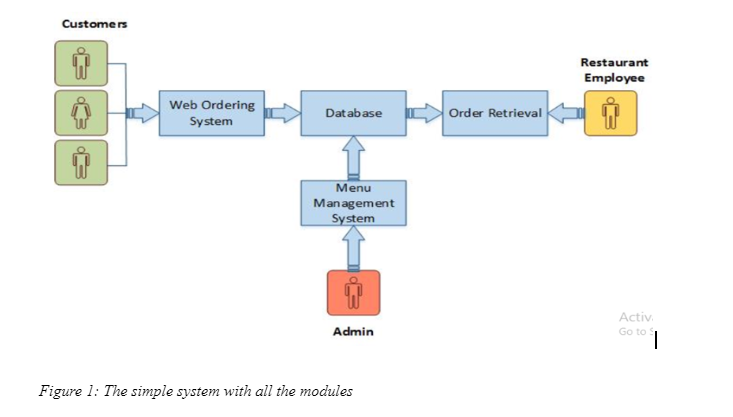
First, the menu management system is user-Administrator only and may not be available for other user. The module gives room for updating, adding and deleting the food category from or to the restaurant menu. It will also give room for updating, adding and deleting the food item. The administrator can update the price and an additional information appended to a given food item. The second module is the web ordering system which allows consumers to create account, manage account, log in, navigate the menu, make an order, add items to the basket, avail payment details and remove an item from the shopping basket. The last module is the order retrieval system which helps in retrieving the new orders, display orders and ensure right graphical compliance. With the help of the agile method, the following design can be implemented.
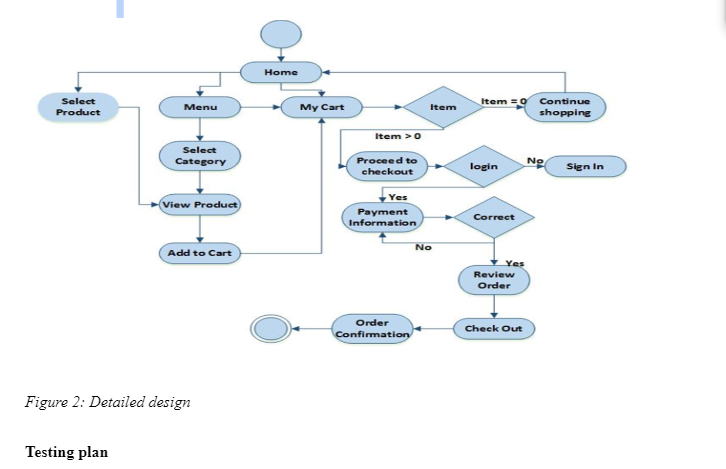
The project intends to perform code speed optimization. However, before doing this, the project focuses on testing the speed of the website with the help of the keyCDN tool. This provides 14 locations and results will be made private. With the help of this tool, it is easier to view the HTTP requests and the load time as well. The keyCDN tools facilitate the online checks known for analyzing the website as well as identifying the connectivity issues. In this context, the online checks that would be put into consideration include the HTTP header check, full page speed check, Geo location check and the SSL FREAK attack tester. The full page speed check does testing on performance issues and website reloading. The speed check is as shown below. Figure 3: the speed and webpage performance test
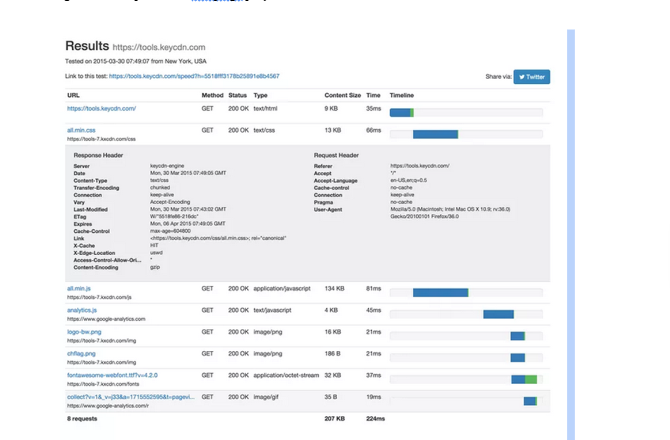
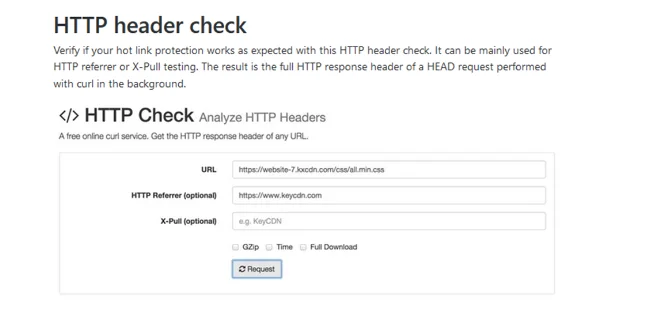
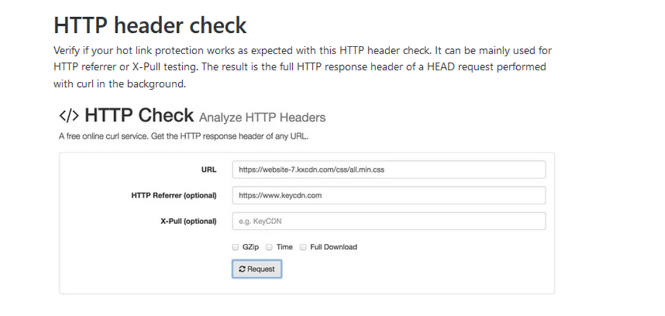
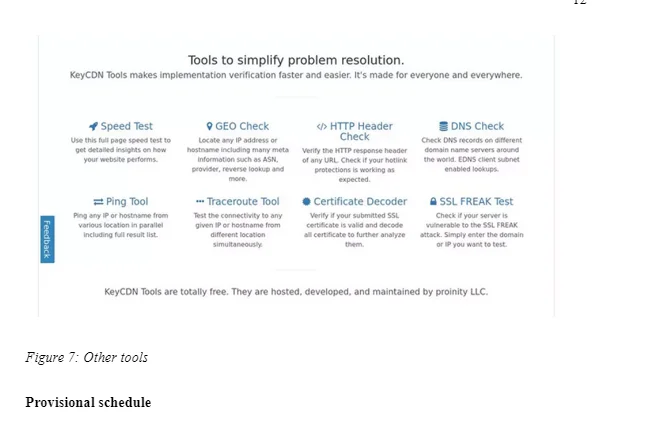
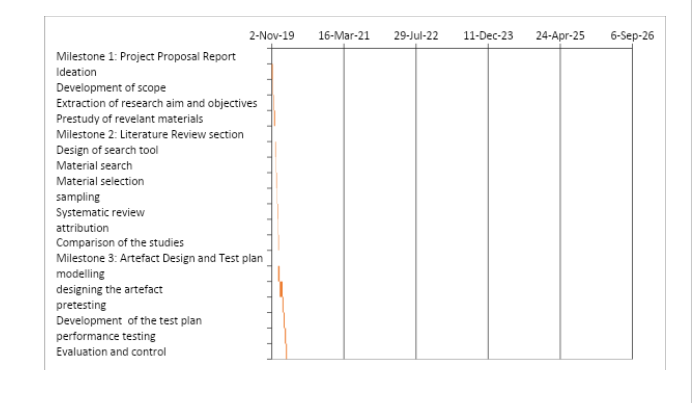

References :
- Patel, M., 2015. Online Food Order System for Restaurants. Available at
- Page, R., 2012. Website Optimization: An Hour a Day. John Wiley & Sons. Grappone, J. and Couzin, G., 2011. Search Engine Optimization (SEO): An Hour a Day. John Wiley & Sons.
- Khan, M.T., Huo, X., Li, Z. and Kanich, C., 2015, May. Every second counts: Quantifying the negative externalities of cybercrime via typosquatting. In 2015 IEEE Symposium on Security and Privacy (pp. 135-150). IEEE. Armstrong, L., 2003. Every second counts. Three Rivers Press.
- Khan, M.T., Huo, X., Li, Z. and Kanich, C., 2015, May. Every second counts: Quantifying the negative externalities of cybercrime via typosquatting. In 2015 IEEE Symposium on Security and Privacy (pp. 135-150). IEEE. Booth, D. and Jansen, B.J., 2010. A review of methodologies for analyzing websites. In Web technologies: Concepts, methodologies, tools, and applications (pp. 145-166). IGI Global.
- Falk, L., Prakash, A. and Borders, K., 2008, July. Analyzing websites for user-visible security design flaws. In Proceedings of the 4th symposium on Usable privacy and security (pp. 117-126). ACM.
- Heber, Y., 2013. System and method for analyzing, generating suggestions for, and improving websites. U.S. Patent 8,498,990. Chotikitpat, K., Nilsook, P. and Sodsee, S., 2015. Techniques for improving website rankings with Search Engine Optimization (SEO). Advanced Science Letters, 21(10), pp.3219-3224.
- Krawczyk, P. and Woda, M., 2013, May. Best Practices For Creating Websites Optimized For Mobile Devices. In ICIT 2013 The 6th International Conference on Information Technology (hal. 1–11). Stone, E.E., Skubic, M., Rantz, M. and Popescu, M., University of Missouri System, 2017. Activity analysis, fall detection and risk assessment systems and methods. U.S. Patent 9,597,016. Kuipers, J., Ueda, T. and Vermaseren, J.A.M., 2015. Code optimization in FORM. Computer Physics Communications, 189, pp.1-19.
- Mattos, D.I., Bosch, J. and Olsson, H.H., 2019. Multi-armed bandits in the wild: Pitfalls and strategies in online experiments. Information and Software Technology, 113, pp.68-81. Krawczyk, P. and Woda, M., 2013, May. Best Practices For Creating Websites Optimized For Mobile Devices. In ICIT 2013 The 6th International Conference on Information Technology (hal. 1–11).
Take a deeper dive into Family Presence During Resuscitation with our additional resources.
- 24/7 Customer Support
- 100% Customer Satisfaction
- No Privacy Violation
- Quick Services
- Subject Experts



